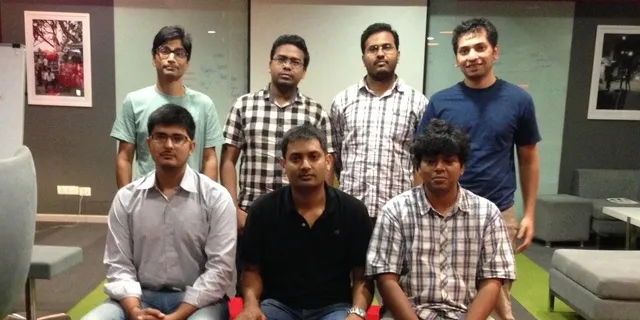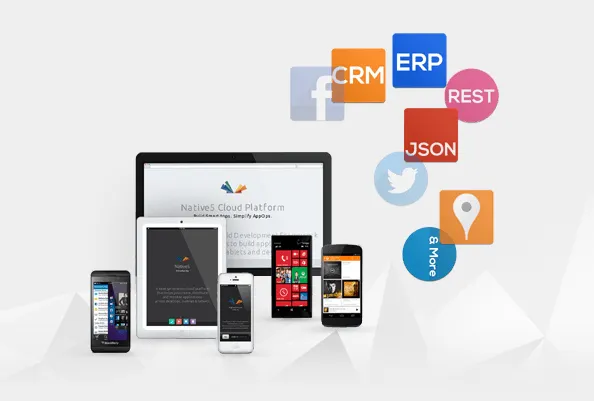Weaving the Internet of Things: Native5
Native5 is in the thick of ‘Internet of Things’. Right where internet has spilled over from PCs to mobiles, tablets, wearables, appliances and vehicles, all connecting to each other, exchanging data and generating new information. This omnipresence of the internet calls out for a platform that enables development, deployment and management of applications for the array of devices and environments already available and those on its way -- Native5 addresses precisely that need.
The company was incorporated in August, 2011 by Kunal Abhishek, Manish Priyadarshi, Barada Sahu (Barry) and Shamik Datta.. The co-founders, with help from their family and friends, put in the initial capital. The revenues started coming in by early 2013. They joined the third batch of Microsoft Accelerator in July 2013 and are graduating this month. For their technology innovation, they were recognized by Qualcomm (finalist QPrize, 2012) and Nasscom (10,000 startups, 2013).
Native5's immediate focus is to provide a toolkit that enables cross platform development and management, across the existing variety of mobiles and tablets through a single, yet open web framework. Kunal Abhishek says. “The platform is not merely an application development framework, but also incorporates cloud services and virtualized infrastructure that include tools for deployment, hosting and management. Developers with a working knowledge of web stack will be able to create powerful applications across platforms through Native5 Platform.”

He tells YourStory that they aim to play pivot in enabling the developer ecosystem for the ‘Internet of Things’.
How do you see the mobile developer ecosystem evolving? Is there a difference between the global trend and Indian?
There are two fundamental shifts in the way mobile development is taking place – the rising importance of ‘social coding’ as well as the unprecedented access to enterprise grade infrastructure for development and deployment. These are bringing about tectonic changes, not only in the way mobile applications are being developed, but also in the sorts of mobile applications that are possible.
Social coding through developer communities such as Github and Stackoverflow have ensured that coding is no longer an isolated activity - in effect developers are increasingly able to build upon each others’ work rather than to 'reinvent the wheel.' This greatly reduces the time to develop new applications. This shift is further accentuated by 'tech evangelism' which is ensuring that developers are exposed to the right tools and frameworks. Taken together, these allow the development of sophisticated systems that otherwise required a lot of expertise.
Additionally, with the growth of infrastructure cloud services and with the growing availability of value-added cloud based infrastructure services, mobile developers have unprecedented access to enterprise grade infrastructure. Going beyond basic infrastructure, there is growth in the sophistication of tools and frameworks available to developer communities.
These trends are shifting the focus from the traditional concentration on channel sales, to developers and developer communities. While events in the early 2000s were held in fancy 5 star locations at great cost, and organized and funded primarily by investor communities, the more recent trend is towards hackathons, organized and funded by large enterprises. Product companies are keen to have a stake and looking to play an important role in the emerging mobile ecosystems. Certainly, developers have unprecedented influence.
How do you plan to scale?
We are ensuring that our touch points with developers are a minimum. We are also ensuring that the developer can start on our platform effortlessly. These two principles have largely influenced the way we are architecting this platform and approaching the market.
From the user’s perspective, and to appeal to the developer ecosystem, we are planning to build a community support network that will empower end users to deal with issues that they might face in using the platform. This is further enabled by our choice to open source any widget libraries we develop, to enrich the ecosystem as well as to enable the developer community to extend and customize for specific requirements.
We have automated repetitive tasks to free up efforts and reduce error. We have a continuous integration strategy that allows us to constantly deliver and deploy our libraries and tools. All APIs and libraries are built on open standards and are extendable. Overall, the system is designed in a manner that allows us to constantly iterate and scale.
What has been the market response so far?
We have been in private beta for the last six months, with two live and three pilot customers. Importantly, three of these five customers are Fortune 500 companies. Each customer is able to use our current solution to create applications on multiple platforms using a single source code.
The feedback has been very encouraging and key to the process of prioritizing features in the product roadmap. This has prompted us to launch the platform on the cloud earlier than we had planned. The developer pre-release in November of 2013 will be limited in scope. We will continue to enhance the platform as we get feedback from a select group of developers.
What can we expect from Native5 in the coming months?
At the onset, we are betting on the use of open web technologies such as HTML5. Though there are issues (such as performance) that still persist, we see a lot of developers (and organizations!) gravitating towards HTML5. Our platform will address some of the core issues that continue to hinder adoption of cross platform technologies, such as performance and fragmentation. Through our tools, we will ensure that cross platform development and management of apps is efficient and easy.
What about Native5 excites you?
The challenges in building a product company, and the opportunity to create mindshare among developers keep us motivated.
We always knew that building a product company in India could be tough because the ecosystem is still nascent. However, we took the road less travelled because we felt that we should address this specific set of challenges for the potentially large impact solving these would have.
For all of us, taking this journey together is exciting enough to keep us motivated.

Who are the brains behind Native5?Native5 has four founding members. I amo an engineering graduate from ISM Dhanbad and did my MBA from IIM Calcutta (2004). I delved into operations and sales through at Kony, Accenture and Virtusa. Barry (Barada) graduated from IIT-KGP in 2002 and worked at Kony Solutions, Capgemini and Ocimum Biosolutions, where he developed frameworks and tools and cultivated a deep understanding of open source and enterprise software. Shamik graduated from IIT-Mumbai in 2002 and worked at DSipher Design Solutions and Freescale. He has a breadth of technology experience that ranges from embedded systems to high availability cloud infrastructure. Barry and Shamik are the key architects of the Native5 platform and drive the technical direction of the product.
Manish is an engineering graduate from University of Pittsburgh and an MBA from Wharton in 2009. He has had previous stints at Sprint and Artisan Partners, where he developed expertise in product management and sales. Manish and I jointly manage the responsibility of product management, operations and sales.
What is the story behind the genesis of Native5?
The team goes back a long time before Native5 was formed. Manish and I went to high school together, and I have known Barry and Shamik for over a decade. All four of us worked in startups and large organizations before coming together to start Native5. In fact, Shamik and Barry were co-founders of their own respective set-ups before they chose to co-found Native5.
We believe that we are addressing an important need for high quality tools to ease much of the labour and frustration developers and IT managers face today, which will irreversibly improve the developer ecosystem. Our team is motivated by the opportunity to address a hard problem, the nature of which keeps changing given the speed with which the ecosystem is evolving. In addition, the necessity to innovate, learn and relearn things constantly, and to deliver value through the product makes the challenge enjoyable.
Visit the Native5 website here.







